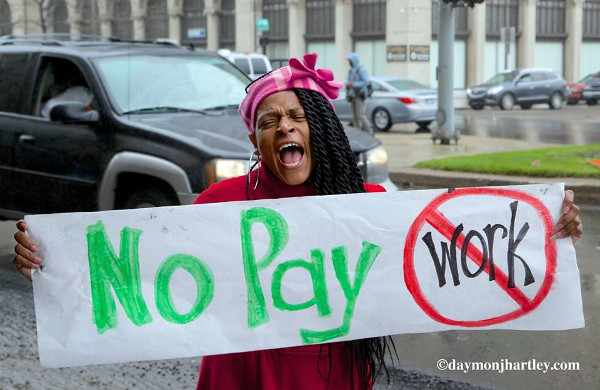
PHOTO/DAYMONJHARTLEY.COM
The destruction of our public school system in favor of privatized corporate run schools began long before Trump, under both Republican and Democratic administrations. Why do corporations want our public schools? Because they want the annual taxpayer funded education budget of $607 Billion!
One of their first steps has been to target the $287 billion in public school teacher pay and benefits. In Ohio, for example, charter schoolteachers make 59% of what public school teachers make. If corporations paid all teachers at the Ohio rate, the potential profit could reach $118 billion. But are kids getting a better education in private schools? Stanford University studied test data from 27 states. In reading, 75% showed no improvement or significantly worse results. In math, 71% showed no improvement or significantly worse results.
Billionaire Betsy Devos, Trump’s Education Secretary, aims to ensure corporate for-profit schools, diverting billions from public education. In her home state of Michigan, Detroit public schools are privatized or left with rats, falling ceilings and broken plumbing. Our only solution is to join the fight for the national public ownership of public education, the only way to guarantee quality education for every child.
(Information from Yes! Magazine infographic)
Hungry to learn
Contributed to the People’s Tribune by educators
Homelessness and food insecurity now affects every level of public education, from pre-school to K-12 through higher education.
At the University of Hawaii 21% of students are food insecure. For City University of New York, it’s 39%. More recent reports indicate that over half of the students attending certain colleges in Oregon, Maryland, and Alaska are food insecure. In one of the few studies on the topic, 20% of students reported being hungry and 13% were homeless.
Massachusetts has 29 public college campuses; 25 have food assistance programs. UCLA is opening a food bank. At California’s 23 Cal State level campuses, 20% of students are food insecure. At the state’s community college level, 33% of students go without adequate food during each month. The United Teachers of Los Angeles has made one of their contract demands that all schools become community schools with a 360 wrap-around of necessary services. (Data from Wisconsin Hope Lab, “Hungry to Learn” 2015.)
In the 2012-13 school year, 51% of students from pre-k-12 were eligible for the federal program that provides free and reduced-price lunches. The lunch program is a rough proxy for poverty, but the explosion in the number of needy children in the nation’s public classrooms is a recent phenomenon that has been gaining attention among educators, public officials and researchers.
Hunger is increasing in an era when an abundance of food is being produced. How can students learn if they are hungry? What is wrong with this picture?
Why do corporations want our public schools?
Latest
Free to republish but please credit the People's Tribune. Visit us at www.peoplestribune.org, email peoplestribune@gmail.com
The People’s Tribune brings you articles written by individuals or organizations, along with our own reporting. Bylined articles reflect the views of the authors. Unsigned articles reflect the views of the editorial board. Please credit the source when sharing: ©2024 peoplestribune.org. Please donate to help us keep bringing you voices of the movement. Click here. We’re all volunteer, no paid staff.

